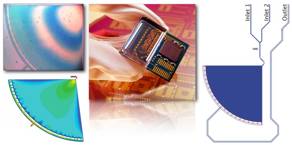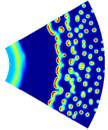The idea of studying pattern formation, especially self-replicating spots and spiral waves, e.g., in the Gray-Scott model (Gray and Scott, 1984; Pearson, 1993; Lee et al 1993), in the context of artificial life and self-replication is not new. Theoretical work (Cronhjort and Blomberg, 1997) has established that spatial concentration patterns can provide a mechanism for avoiding mutant chemical species harmful for the pattern formation, or "viruses". McCaskill and co-workers designed a chemical system, CATCH (cooperative amplification by cross hybridization), which made it possible to study cooperative evolution of pattern forming systems in the laboratory (Ehricht et al 1997, Wlotzka and McCaskill 1997; Ellinger et al 1998; Ackerman et al 1998).
We have developed a new model for chemical pattern formation based on the Gray-Scott reaction scheme (Gray and Scott 1984). Guided by an information-theoretic analysis (Lindgren et al, 2004), we have made an extension of the the version of the model that drew considerable attention when self-replicating patterns were observed experimentally and in simulation (Lee et al 1993, Pearson 1993). Most work on chemical pattern formation since Patrick de Kepper’s first observation of Turing patterns, has been performed with gel-slice reactors (Castets et al 1990), where patterns emerge in a gel coupled to a spatially extended homogeneous medium. Our extension adds slow-release chemical reservoirs, common in a variety of technical settings such as artificial cell research, allowing for pattern formation under flow in an otherwise closed system, which seems implausible with the original model.
On the micro-scale many
properties of a fluid are drastically different than on the macroscopic scale.
Most important for the reaction-diffusion processes is the possibility for
stable operation in the laminar phase. On the micro-scale it is possible to
have systems where diffusion completely dominates the mixing of reactants, but
at the same time it is possible to have a continuous in- and out-flow of
different chemical species. The recent development of micro-fluidic chips can
be used to control the mixing and reactions of chemicals within chambers and
channels that are 100 microns wide. The entire setup is usually integrated on a
single chip and controlled by a digital computer. Microfluidic flow reactors
provide an ideal experimental setup for studying self-replicating and other
dynamic patterns in controlled chemical systems. Especially the fan reactor,
invented in McCaskill's group (McCaskill et al 2005), utilizes a simple
geometric design to control the diffusive pattern formation process.
(a) (b) (c) (d)






